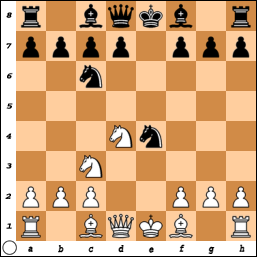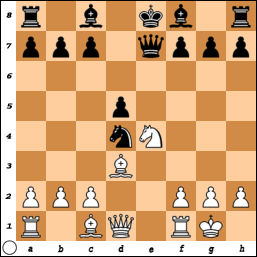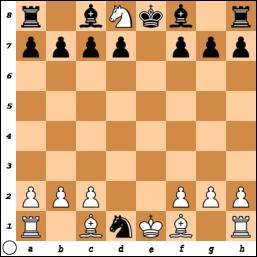There is another interesting variation in open games, in which Black also provocatively takes the pawn with the knight on e4.
Four Knights Game (C47)
1.e4 e5 2.Nf3 Nc6 3.Nc3 Nf6 4.d4 exd4 5.Nxd4 Nxe4

The following line pretends to refute this risky taking:
6.Nxe4 Qe7 7.f3 d5 8.Bb5 Bd7 9.Bxc6 bxc6 10.0-0 dxe4

Black’s position is somewhat depressing on both flanks – the structure of the queen’s is damaged, and the king’s has not had time to develop. Nevertheless, thanks to modern analysis, everything is not so clear.
11.Re1[ In the game Karjakin,S (2753)-Vallejo Pons,F (2695) St Petersburg 2018 there was 11.fxe4 c5 12.Nf5 Qe6 13.Bf4 0-0-0 14.Qf3 and according to the Stockfish 16 after 14…g6 15.Qc3 c4 Black is holding on (-0.14 on the depth 50)]
11…0-0-0 12.Rxe4 [If 12.Qe2 than 12..Qb4 is good. The blitz game Oleksienko,M(2592)-Shevchenko,K(2675) continued 13.Qa6+ Qb7 14.Qxb7+ Kxb7 15.Rxe4 c5 16.Nb3 Bf5 17.Rc4 Rd1+ 18.Kf2 and after 18…Bd6 19.Nxc5+ Ka8 20.Nb3 Rb8 the Black’s initiative compensates for the lack of a pawn] Qb4! In this complicated position White has several options. Black’s ideas are to keep the queen closer to the king and, if possible, to make exchanges. And, of course, to watch the tactics.
13.Nb3 [After 13.Qe2 Bc5 14.Be3 (14.c3 Qb5) 14…Rhe8 15.c3 Qa4! Black are holding on, if 13.с3 Qb6 with the idea с6-с5 Black can seize the initiative] Bf5!? Black gets a slightly worse endgame, which is close to equality. An alternative is the computer-style 13…Qb7 with complex playing.
14.Qxd8+ Kxd8 15.Rxb4 Bxb4

16.Be3!?
One of the equation methods that the computer offers is worth noting:
16…Bd6!? 17.Bxa7 Bxc2 18.Nd4 Bg6 19.Nxc6+ Kd7 20.Rc1 Re8 21.Kf2 Bxh2 22.g3 h5
White has an extra passed pawn. But Black has good counterplay due to the presence of 2 bishops. Stockfish 16 evaluation is 0.02 (depth=54).
Among other White’s attempts, the following continuation deserves attention:
7.Bd3 Nxd4 8.0-0 d5

9.Ng5 [If 9.Bc4!? – the exact reaction would be 9…Nf3+ 10.Qxf3 Qxe4 11.Bxd5 Qxf3 12.Bxf3 Be7 13.Re1 c6 14.Be3 Be6 with equal endgame] 9…Ne6 10.Re1 h6 11.Nf3 Bd7
After 12.Be3 (12.Bf4 0-0-0 13.c3 Kb8 14.Bg3 g6 15.Qb3 Bg7 leads to a game with opposite castling and mutual chances) Qd6 13.Nd4 g6 14.Nxe6 Bxe6 15.Bd4 Rg8 16.c4 dxc4 17.Bxc4 0-0-0 18.Bxe6+ fxe6 19.Qe2 a6 White semi-forces a position with the almost dead e6 pawn, but only almost. It looks unsafe, but apparently Black can consolidates with careful playing.
If 7.Qd3 d5 8.Nb5!? than 8…Nb4! 9.Qe2 Qxe4 10.Nxc7+ Kd8 11.Qxe4 dxe4 12.Bf4 Nxc2+ 13.Kd2 Nxa1 14.Nxa8 Be6 with equality.
At the end of the review, we will consider another natural reaction of White to 5…Nxe4.
6.Nxc6 Nxc3 7.Nxd8 Nxd1

8.Nxf7 Kxf7 (8…Nxf2? 9.Nxh8 Nxh1 10.Be3!) 9.Bc4+ Kf6 10.Kxd1 (10.h4 Nxf2 11.Kxf2 d5 12.Bxd5 Bc5+ 13.Kg3 Bd6+) 10…c6 11.Be3 d5 12.Bd3 Bd6 13.Re1 Kf7 – equal endgame